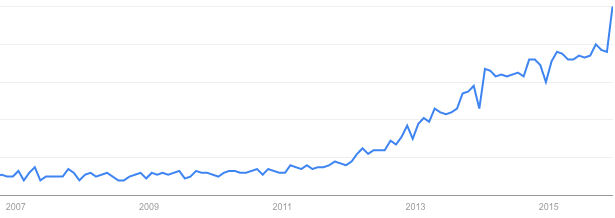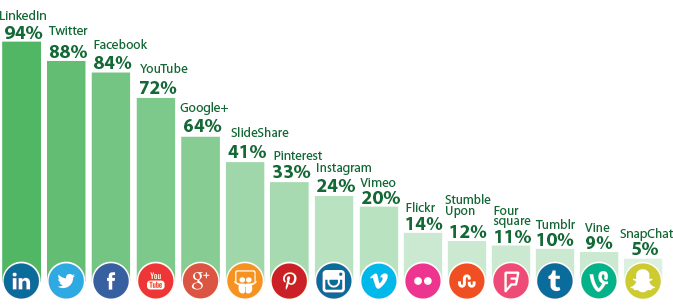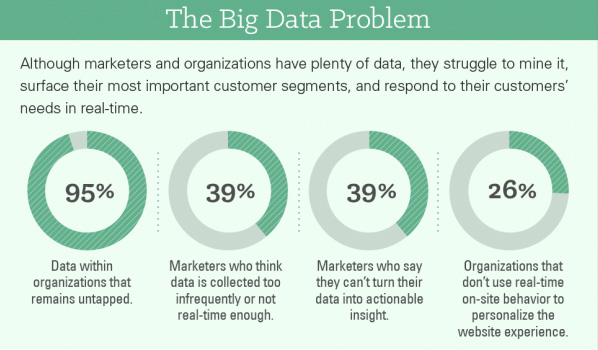4 B2B Content Marketing Trends You Need To Know for 2017
There is a hungry audience out there for content. The Google Trends graph below shows that interest in “content marketing” has jumped 20% in Q4 of 2015, although it has climbed steadily since the inflection point, 2011. The growth in 2015, which was as much in two months as it was over the past two years, tells us the hunger is real, although it isn't necessarily there for every single blog post as there is over 2 million created every day. This results in a head to head competition for the enterprise content marketing space amongst the vast amount of content creators out there.

Content marketing that is driven by data and done with purpose works. Does that sound like a biased statement? Then let me back it up with some stats first, before diving into the 4 content marketing trends that will keep you on top in 2017:
-
According to one of the most recent studies, 74% of companies are increasing lead quality and quantity from content marketing.
-
41% of organizations with content marketing programs say they see an increase in brand awareness.
-
Content marketing costs 62% less than traditional marketing and generates about 3 times as many leads, according to Demand Metric.
-
Research from NetProspex puts a strong emphasis on the role of content, revealing that 75% of the 478 global CMOs and senior marketing executives surveyed think that “…marketing will be responsible for the end-to-end customer experience” over the next “3-5 years".
-
Although CMI claims that 56% of B2C marketers and 64% of B2B marketers don’t have a documented content marketing strategy in place, fortunately, some must have realized the importance of the systematic approach to content marketing, as 75% of content marketing leaders are increasing marketing technology investment in 2016, according to the recent study.
-
Another interesting point comes from the study conducted by Fractl and Moz, that the number of LinkedIn profiles in the U.S. containing “content marketing” has increased by 168%.
-
Curata’s 2016 Content Marketing Staffing & Tactics Study states that 51% of respondents say they will have a content marketing leader by 2017.
-
60% of people are inspired to search for a product after reading about it, and 70% of people would rather learn about companies through an article than a commercial.
So the list goes on but the content marketing garden is not all rosy, especially for B2B marketers. Content Marketing Institute’s 2016 Benchmarks, Budgets, and Trends report for North American B2B Content Marketers reveals just 30% of B2B marketers define themselves as “effective.” That’s down from 38% the last year, equaling a 21.05% drop. This means that 70% are ineffective and clearly B2B companies are having a tough time.
Google Digital Marketing Evangelist, Avinash Kaushi, says “Content is anything that adds value to the reader’s life.” Many of us know that is a fundamental of content marketing, however we are still way too focused on campaigns and selling our services/products. Here are some tactics that we should all consider if we'd like to see what we can do better for our business while the audience truly enjoys our content:
Social Media is Still Powerful
You might be thinking that social media is stale. Well, it depends on how you utilize it. A research study from the Direct Marketing Association shows social media, in terms of effectiveness for businesses, is still in its “infancy” and suggests that social media will grow to 24% of marketing budgets within five years, up from 10% today. Not only does this study dictate where social media is going, but many experts also believe that paid social will be accepted as a necessary part of any social media strategy. To that point, in 2015, advertisers spent $23.68 billion on paid social media advertising. By 2017, that number should increase by 33.5% to $35.98 billion reports eMarketer. Here’s how content marketers distribute content across social networks:

There are also some predictions that Google will buy Twitter for tens of billions of dollars, and the only reason they would do that is for generating revenue through ads. If that happens, the ROI for purchasing advertising on Twitter will go up.
With the effectiveness of social media in mind, sharing content on social media is just the tip of the iceberg and should be closely followed by data-driven marketing activities in order to embrace what’s working and change what’s not. According to DMA’s research, 70% of companies are still not collecting data from social media channels which is a huge mistake, as marketers who check their metrics more than 3 times a week are over 20% more likely to achieve a higher ROI.

Virtual Reality: Put Your Audience at the Center of Your Stories
The future of visual storytelling comes in a number of forms, whether that is new technology, innovative content creation or traditional photography. Telling a compelling story around the brand is the secret sauce as nothing is more effective than an engaging and emotive storyline that audiences can relate to. With that in mind, virtual reality will be a strong medium for those who are looking for new ways to tell a story and engage their audiences.
VR is especially helpful for B2B marketing where telling the 'story' of a complex sale is a content challenge. It is also a considerable investment, compared to flying a lot of senior executives over to just review a prototype. It definitely makes sense in many ways. After all, sales increase when more senses are involved. Forward-thinking marketers believe that VR will be more than just hype, and the prediction is that there will be 24m VR and AR headsets in 2018.
General Electric, for instance, celebrated the launch of its Brazilian research center in late 2014 with a VR installation. Visitors to the facility could see what a subsea factory looked like from the comfort and safety of an armchair. GE has now created VR experiences for all the major platforms including Oculus Rift, Samsung Gear VR, Google Cardboard and YouTube 360, that all showcase the company’s work in technology.
“Like everything else, this would start as a competitive advantage for those early adopters,” says Jeff Kagan, an independent industry analyst. “Then, over time, it will become the way we do things. At that time, companies who don’t do it this new way will be behind the eight ball.”
B2B eCommerce
According to the Forrester report, B2B companies sell about $780 billion of their products and services online. By 2020, that number could increase to $1.13 trillion, representing a 44.8% growth. In fact in some cases, B2B companies can only sell profitably to their prospects by doing it online.
“B2B buyer behavior has changed dramatically in the recent years,” Forrester says in the report, which was authored by e-business analyst Andy Hoar along with other Forrester analysts. “Both professional and non-professional B2B buyers are now taking a digital-first approach to discovering and making purchases.”
Forrester is not the only one estimating this, as Gene Alvarez, Vice President and Analyst at Technology Research and Advisory Firm Gartner Inc., estimated U.S. B2B online sales are at about $800 billion and increasing rapidly to $1 trillion. Another report, by research firm Frost & Sullivan, projects that U.S. B2B e-commerce sales will reach $1.9 trillion by 2020, as global B2B online sales will reach $6.7 trillion.
Forrester also notes that 52% of B2B executives say they have reduced their customer-support costs by migrating offline customers online, and 56% say they have customers they can only serve profitably online.
Just because e-commerce sites are expected to go big in 2017, doesn’t mean you can nail it without a content strategy. This space requires specific content that goes beyond the description of the product. According to the studies, valuable content such as ‘how-to’ videos are essential to engage customers along with grabbing their attention. B2B businesses are starting to generate some serious revenue through their e-commerce efforts, but, there’s still a lot of room to grow.
It’s important to remember customers want content that’s tailored to their preferences, like personalized product recommendations, customized product catalogs, and relevant pricing. Personalization is a key competitive advantage as 80% of people enjoy learning about companies through custom content.
I highly recommend watching the video below from the most recent episode of CMS-Connected as Industry Analyst Scott Liewehr and Arthur Lawida, President at commercetools US, discuss how e-commerce platforms are now offering content management and whether or not these platforms can offer enough to deliver a unique experience that builds loyalty, attracts repeat customers and cultivates customer advocacy.
And the Oscar Goes To… User-Generated Content
As Leah Kinthaert pointed out in the 50th episode of the CMS-Connected Show: “Only 1% of millennials trust the products in ads”. Why? They see them as not authentic. Conversely, user-generated content (UGC) is seen as more authentic, trustworthy, and engaging as it tells a story. Authentic content is not a trend or a new way, but I assure you it is more emerging than ever. Though B2C marketers seem to have fully embraced the concept, B2B marketers are just getting started.
Content created by a brand is still informative, but when it’s written by peers, that content is instantly considered more trustworthy. Therefore, content created by users for users will be dominating 2017. So, now we all understand the importance of UGC. The next question is, how are we going to make our audiences feel inspired and motivated to take action? Yes, some customers willingly share reviews because they are simply excited about your products, but an effective UGC strategy shouldn’t rely on the goodwill of customers alone. They need incentives to share their ideas. Here’s a little help:
-
Contests are an effective way to make the audience feel inspired and motivated to take action. For example, in 2014, Intuit, the software provider for Canadian tax preparers to prepare and file taxes, was looking for a deeper way to engage with small business customers. Intuit knew that the one thing a small business never has enough of are resources—or, in this case, advertising budget. With that in mind, they decided to hold a contest that would help a small business make a very big splash through advertising. And not just any advertising: Intuit was going to give away a Super Bowl Ad. Brands were asked to submit a video telling their story as their entry to the contest. Thousands of companies participated, and millions voted. Integrating UGC into Intuit’s marketing created a unique marketing opportunity for both its customers and its own brand. As a result, it worked remarkably well.
-
Creating B2B communities are getting more popular. Many firms have started to create forums where professionals can discuss trends and ask for advice from peers. The outcome is twofold as the firm can also discover the pain points to make improvements while engaging deeply with the audience.
-
Create UGC rooted in the goal of asking customers for ideas. For example, CRM platform Salesforce did this when creating a site called Idea Exchange. This site enables people to suggest new features for the company’s products and vote on their favorite ideas. The ideas with the most “likes” and comments appear at the top of the page.
-
Influencer marketing is very important as distributing user-generated content to prospects, written by their peers, creates a higher sense of trust. Xerox, for instance, created Chief Optimist, which is a magazine exclusively for senior decision-makers at large enterprises. Their publication features content that’s contributed by influential customers and business stewards from around the world.
You can start small by defining a small UGC campaign to test its success and effectiveness. Then expand your efforts if it’s successful, or revise if you think you can make it better.
The 2016 State of User-Generated Content from Chute
Before You Go
Today, B2B marketers use an average of 13 content marketing tactics. No matter what tactics you adopt, giving your reader value from the time they spent reading your content is key. Keep your message designed to entertain, educate or both. It’s also time to ditch the brute force tactics like misleading messaging, clickbait and sensationalist headings like "You won't believe this," or "You will never guess what happens next”. Generally, this content does not live up to the hype, and in effect wastes someone's time and that is not the memory you want your content to leave them with. Plus, you should never underestimate the intelligence of your audience by way of trickery, people have wised up.
Smaller organizations in particular should shift their focus to delivering personalized, niche content through more targeted channels so they don't find their messages saturating and in-effect, meaningless. They should also strategize their content marketing initiatives with the target of getting higher quality engagement even if it sometimes means delivering a lower volume of content. Understanding the value of crafting premium quality content is where a lot of organizations can miss the mark, and while the solution isn't always easy, it is worth it many, many times over.
What do you think?

Venus Tamturk
Venus is the Media Reporter for CMS-Connected, with one of her tasks to write thorough articles by creating the most up-to-date and engaging content using B2B digital marketing. She enjoys increasing brand equity and conversion through the strategic use of social media channels and integrated media marketing plans.